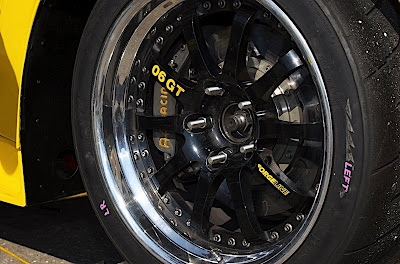The single greatest concern with lug nuts is that you have adequate engagement between the lug nuts and wheel studs. The picture on the left is what you shouldn't have. Notice how the studs don't stick out past the lug nuts. These wheels studs are too short. The engagement between the nut and stud is marginal.
The Southern California Timing Association, which governs the racing at Bonneville, requires at least 5/8 inch of thread engagement. The SCTA also prohibits the use of closed-end lug nuts.
This Mustang is an example of closed lug nuts. We simply don't have a clue about what's going on with closed lug nuts. It's difficult to see how many threads are engaged. The worst case scenario is where the wheel stud bottoms out on the inside of the lug nut and leads you to believe you're tightened the wheel properly. Which you haven't.
Even though you tightened the wheel (so you think) the wheel could still be loose on the hub. Most sanctioning bodies simply don't allow closed lug nuts. Since this is a Mustang running an SVRA vintage race we have to assume someone messed up. SVRA is usually pretty good on safety standards.
This is the way your race car should look. While it might seem the studs are a little long that's simply not a problem. It may look a little strange but these longer studs make it easier to put the wheel in place on the hub and there's no problem with having a little too many threads showing.

We never think about wheel studs and lug nuts. They just exist. When you start changing the wheels around on your car you really need to pay a little more attention to these items. The wheel on the left might be a good example of how it should be done.
Notice in the Porsche wheel at the right that open wheel nuts are used. Even more important theses lug nuts are made out of steel. The stock Porsche 911 lugs nuts are made from aluminum and have a closed end. Most race sanctioning bodies won't let you use the stock Porsche lug nuts. They require that you use this type of steel lug nut.
 Wheel Studs: This is the nut and bolt that gets removed and reused more than any other nut and bolt on your car. How long do these things last anyways? The better question is how much do you abuse your wheel studs. Impact wrenches, both air and electric, have destroyed more wheel studs than any other tool in the shop.
Wheel Studs: This is the nut and bolt that gets removed and reused more than any other nut and bolt on your car. How long do these things last anyways? The better question is how much do you abuse your wheel studs. Impact wrenches, both air and electric, have destroyed more wheel studs than any other tool in the shop.Elastic deformation is the wheel stud’s ability to stretch and spring back to its original shape. The yield point is a situation where the bolt has been stretched past its elastic limit and can no longer spring back to its original shape. If a wheel stud is over-torqued, and stretched past its yield point it can no longer maintain the proper clamp load.
Over-torquing the wheel stud is common because so many people insist on using impact wrenches. Using an impact wrench to install wheels can cause the wheels to have three to five times the specified lug nut torque. The use of lubricants and anti-seize compounds on the threads can cause an even higher degree of over-torquing. You wouldn’t use your impact wrench when you install your cylinder heads. So why are you using it on your lug nuts?




